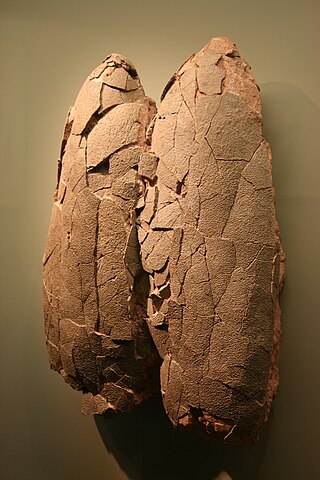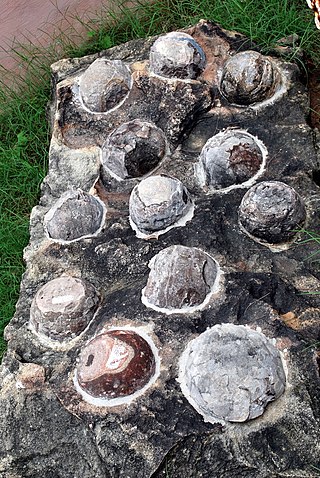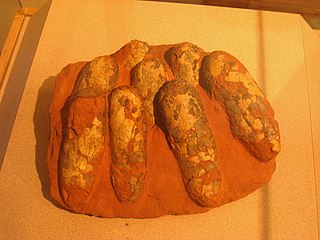
Elongatoolithus is an oogenus of dinosaur eggs found in the Late Cretaceous formations of China and Mongolia. Like other elongatoolithids, they were laid by small theropods, and were cared for and incubated by their parents until hatching. They are often found in nests arranged in multiple layers of concentric rings. As its name suggests, Elongatoolithus was a highly elongated form of egg. It is historically significant for being among the first fossil eggs given a parataxonomic name.
Dictyoolithus is an oogenus of dinosaur egg from the Cretaceous of China. It is notable for having over five superimposed layers of eggshell units. Possibly, it was laid by megalosauroid dinosaurs.

Cairanoolithus is an oogenus of dinosaur egg which is found in Southwestern Europe. The eggs are large and spherical. Their outer surface is either smooth, or covered with a subdued pattern of ridges interspersed with pits and grooves. Multiple fossil egg clutches are known but the nest structure is unclear.
Shixingoolithus is an oogenus of dinosaur egg from the Cretaceous of Nanxiong, China.

Macroelongatoolithus is an oogenus of large theropod dinosaur eggs, representing the eggs of giant caenagnathid oviraptorosaurs. They are known from Asia and from North America. Historically, several oospecies have been assigned to Macroelongatoolithus, however they are all now considered to be a single oospecies: M. carlylensis.

Macroolithus is an oogenus of dinosaur egg belonging to the oofamily Elongatoolithidae. The type oospecies, M. rugustus, was originally described under the now-defunct oogenus name Oolithes. Three other oospecies are known: M. yaotunensis, M. mutabilis, and M. lashuyuanensis. They are relatively large, elongated eggs with a two-layered eggshell. Their nests consist of large, concentric rings of paired eggs. There is evidence of blue-green pigmentation in its shell, which may have helped camouflage the nests.
Phaceloolithus is an oogenus of dinosaur egg found in the Fenshui'ao Formation of the Dongting Basin of the Hunan Province of China. The eggs have a subspherical shape, measuring up to 168 mm on the long axis, and having a very thin shell.
Continuoolithus is an oogenus of dinosaur egg found in the late Cretaceous of North America. It is most commonly known from the late Campanian of Alberta and Montana, but specimens have also been found dating to the older Santonian and the younger Maastrichtian. It was laid by an unknown type of theropod. These small eggs are similar to the eggs of oviraptorid dinosaurs, but have a distinctive type of ornamentation.
Ageroolithus is an oogenus of dinosaur egg. It may have been laid by a theropod.

Egg fossils are the fossilized remains of eggs laid by ancient animals. As evidence of the physiological processes of an animal, egg fossils are considered a type of trace fossil. Under rare circumstances a fossil egg may preserve the remains of the once-developing embryo inside, in which case it also contains body fossils. A wide variety of different animal groups laid eggs that are now preserved in the fossil record beginning in the Paleozoic. Examples include invertebrates like ammonoids as well as vertebrates like fishes, possible amphibians, and reptiles. The latter group includes the many dinosaur eggs that have been recovered from Mesozoic strata. Since the organism responsible for laying any given egg fossil is frequently unknown, scientists classify eggs using a parallel system of taxonomy separate from but modeled after the Linnaean system. This "parataxonomy" is called veterovata.
Paraelongatoolithus is a late Cretaceous oogenus of Chinese fossil egg, classified in the oofamily Elongatoolithidae, which represents the eggs of oviraptorosaurs.
Stalicoolithidae is an oofamily of fossil eggs.
Coralloidoolithus is an oogenus of dinosaur egg from the Tiantai Basin in Zhejiang Province, containing a single known oospecies C. shizuiwanensis. Formerly, it was classified in the oogenus Paraspheroolithus; however, it was considered sufficiently different to be classified in its own genus. C. shizuiwanensis is similar to Stalicoolithus, leading to their classification in the same family, Stalicoolithidae.
Paradictyoolithus is an oogenus of dictyoolithid dinosaur egg from the Zhejiang Province, China. They are nearly spherical eggs, measuring up to 13.9 cm (5.5 in) in diameter, and have a thin eggshell. Their shells are made up of three or four superimposed layers of eggshell units. The two known oospecies are distinguished mainly by their pore structure.
Similifaveoloolithus is an oogenus of fossil dinosaur egg from the Tiantai basin in Zhejiang Province, China. It is the sole known oospecies of the oofamily Similifaveoloolithidae.
Hemifaveoloolithus is an oogenus of fossil dinosaur egg from the Tiantai basin in Zhejiang Province, China. It is a faveoloolithid, having spherical eggs roughly 13 cm in diameter. The shell is distinctive for being composed of four or five superimposed layers of shell units, and the honeycomb-like arrangement of pore canals.

Elongatoolithidae is an oofamily of fossil eggs, representing the eggs of oviraptorosaurs. They are known for their highly elongated shape. Elongatoolithids have been found in Europe, Asia, and both North and South America.
Undulatoolithus is an oogenus of Chinese fossil dinosaur egg belonging to Elongatoolithidae. It is very similar to Macroolithus, but has different ornamentation. Like other elongatoolithids, it was probably laid by oviraptorosaurs.
Nipponoolithus is an oogenus of fossil egg native to Japan. It is one of the smallest known dinosaur eggs, and was probably laid by some kind of non-avian maniraptor.
Nanhsiungoolithus is an oogenus of dinosaur egg from the late Cretaceous of China. It belongs to the oofamily Elongatoolithidae, which means that it was probably laid by an oviraptorosaur, though so far no skeletal remains have been discovered in association with Nanhsiungoolithus. The oogenus contains only a single described oospecies, N. chuetienensis. It is fairly rare, only being know from two partially preserved nests and a few eggshell fragments.





